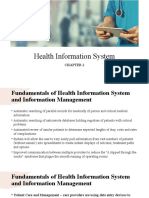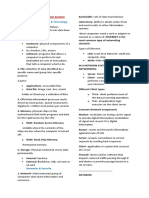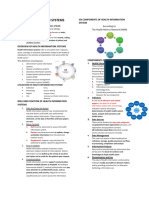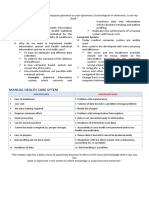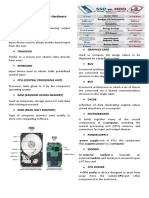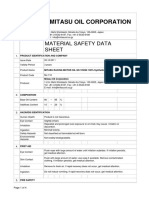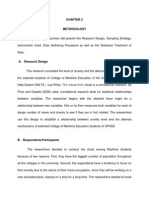Chapter 5 FEEDBACK relationship with other
INFORMATION MANAGEMENT Block diagram of input and output relationship
B. Health Information Management
Process/
─ Primary goal of HIM Input information Procedure
Output results
Organization of and administration of data,
information and knowledge effectively through Without feedback
standard process and quality procedure
** Management is often associated with planning,
Process/
control and implementation Input information Procedure Output result
Data Management Component
With feedback
Data Categories Administration of Information ** Each element may depend or adjusted accordingly
Clinical Data Strategic Planning The input system should have the capability of
Demographic Data System Planning gathering (manual, automatic or combination),
Statistical Data Integration of Information selective capturing, and intelligent collection
Financial Data Manage Quality and process.
References Quantity of Information
Research Data Organize process and ELECTRONIC HEALTH RECORD
Epidemiology Data procedures HER/EMR refers to the systematized collection of
Prepare Information
patient and population electronically-stored health
dissemination
information in a digital format. These records can be
shared across different health care settings. EHRs
C. Health Information Professional
may include a range of data, including demographics,
Are experts who secure, analyze, integrate,
medical history, medication and allergies,
administer and manage information on health care.
immunization, radiology images, vital signs, personal
HIS Professional
statistics like age and weighht and billing information
Health statistical officer
E. Information system process
Solve statistical problem
Database Definition
A database is a set of related data that has a
Perform statistical process
regular structure and that is organized in
such a way that a computer can easily find
Statistical analysis.
the desired information.
**ENTER DATA -> Choose Procedure ->Compute
A data base is a collection of information
compiling various administrative and health
that is organized so that it can easily be
statistics; coding diseases; operations, and
accessed, managed and updated.
procedures and performing utilization review
A data base is a collection logically related
procedures.
data.
Other functions could include maintaining statistics,
SUPER HOSPITALS
transcribing medical reports, and supervising Chang Gung Memorial Hospital – 9000 bed
employees. capacity
Health Information Officer Resource Information Zheng Zhou Hospital – 7000 bed capacity
Process Information Ownership of Information West China Hospital – 4300 bed capacity
Retrieve Data Information Structure Clinical Centre of Serbia – 3470 bed capacity
Store Data Content of Information Chris Hani Baragwanath Hospital – 3400 bed
Perform Statistical Component of Data capacity
Calculation Information New York Presbyterian – 2,328 bed capacity
Manipulate Data Appropriateness Philippine General Hospital – 1,500 bed capacity
Analyze Data Correctness of Data Ilocos Training and Regional Medical Center
Secure Data Reliability of Data (ITRMC) – 300 bed capacity
Lorma Medical Center – 150 bed capacity
Regarding processing data, it is expected that a good
D. Defining An Information System information system manager should be able to
possess good components of information structure convert, manipulate raw data into some useful type
that are highly integrated to one another. of output such as graphical output or digital or
The parameters of the information system are also analogue signal to control system.
essential in defining a certain information system. CENTRAL INFORMATION DATA BASE
Example: the data shown is taken from 120 Episode-level information is required to manage an
patient of certain hospital in Manila with the individual episode of service contract.
height and weight will be used to determine the Case-level information is required to care for an
body mass index individual service user
E. Information system process Facility-level information is required to manage the
specific service facility, whether the facility is a
A typical information system processes are typically
specialist institution or a primary health care.
identified as INPUT, PROCESS and OUTPUT with System- level information is required to develop a
� policy and plan for the mental health system as a
whole
The processed output data can either be stored or
transmitted to other data base.
HEALTH INFORMATION AND RESEARCH
Reliable and timely Health Information Measures
Health determinants
Health systems performance
Health status
A good system is one were Health Information is:
Produced
Analyzed
Disseminated
Used
Health Information is a national asset and used by many:
Policy-makers
Planners
Health care providers
Development partners
Th general public
Uses:
Track health system performance
Support better health policies
Make effective health-related decisions
There are several benefits to information systems,
however, several problems maybe encountered in
each of the stages: collection, processing, analysis,
dissemination and application.
These problems are made worse by changes in the
health system as whole in terms of both structure
and staff turnover.
Careful planning in the design and implementation of
information systems is therefore essential for
overcoming theses common problems.
A good-quality information system can be
categorized by the functional areas they serve, the
extent of structure, the impose on work task, field of
application, purpose, span of information and the
processes type.
Areas of Service
Process Type
Structure of Work process
Field of Application
Span of Information
From admission to diagnostic and medical support
services, the modern healthcare centers and clinic
rely on wide range of software application and
statistical processor.
Some of the distinctive advantages of HIS include
improves quality of patient care, improved
communications within the hospital, increased
productivity, reduced costs and reduced chances of
errors and the enhanced ability to track patient
records.
Today HIS and electronic medical records (EMR) have
become the minimum prerequisites for delivering
quality healthcare in other countries.

